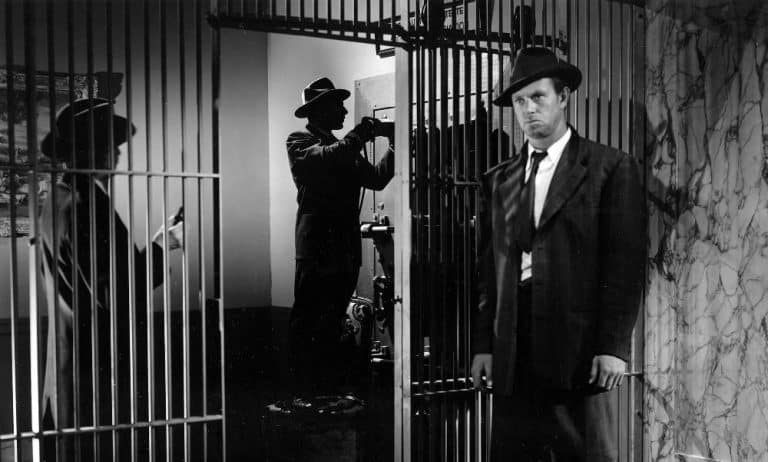Film noir is one of the most beloved and parodied filmmaking styles of all time. Some see it as a genre in its own right. Others argue that it’s too varied to be easily defined. Wherever you stand, it was a big part of Hollywood for two decades, and still influences modern directors.
So, if you’re a film noir newbie, don’t go anywhere. We’re about to break down what it means, how it came about, and what themes define it.
What is Film Noir?
You probably realize that ‘film noir’ is a French term. The literal translation is ‘black film’, although ‘dark film’ matches the intent of Nino Frank, the critic who coined it.
A film noir is a crime drama released in the 1940s and 1950s. Stories involving private eyes and femme fatales are strongly associated with this niche. However, many other plots and genres overlap with film noir, so it’s surprisingly flexible.
Film scholars Raymond Borde and Etienne Chaumeton set down five defining factors of film noir. These are:
- Oneiric (dreamlike)
- Strange
- Erotic
- Ambivalent
- Cruel
While not universal, they’re handy to look out for. Also, ask the following questions to work out if you’re watching a film noir:
- Does it show the world in a detached, surreal way?
- Are there unusual goings-on in the dark corners of society?
- Is there sexual tension between the main characters, and the possibility of betrayal?
- Do they suffer cruelty, or behave cruelly themselves, even without justification?
- Is there a cynical worldview?
A Brief History Of Film Noir
Like many movie categories, the term ‘film noir’ didn’t emerge until after its peak. Nino Frank may have coined it in 1946, but its mainstream adoption took almost 30 years. Before the 1970s, the movies we now call film noir got labelled as melodramas.
Modern critics draw a clear line drawn between classic film noirs and neo-noirs. Classic film noirs dominated during the 1940s and 1950s. Neo-noirs gained a foothold in the 1970s, although some argue that they originated in the 1960s.
In addition, the history of film noir, and in turn neo-noir, mirrors the history of film criticism. Scholars often come up with neat terms to describe broad concepts. Then their contemporaries, rivals and successors then spend decades debating their arguments.
Two other important factors feed into film noir’s history:
German Expressionism
Before the dark, broody and unsettling film noir classics hit cinemas, there was German Expressionism. It covered various art forms, and directors like Fritz Lang championed it on the silver screen. The Second World War brought many of these leading lights over to Hollywood. Their arrival paved the way for classic noir’s birth.
Consequently, aspects of Expressionist presentation, including strong use of shadows and stark lighting, became staples of film noir.
Hardboiled Fiction
International directors inspired the look of film noir, but the stories were thoroughly American. Authors of pulpy crime fiction in the 1920s and 30s created just the type of troubled hero that audiences adore. Raymond Chandler is the best-known, and his books were adapted as the classic noir genre gained momentum. He went on to write original screenplays which fuelled film noir during its heyday.
Common Themes & Tropes Of Film Noir
As mentioned, film noir isn’t limited to a single genre. However, some themes tie together the movies that meet its definition. These include:
Crime
Virtually every film noir features crime at the heart of the story. The most common of these is murder, although theft, blackmail, and fraud are also often used. Crime motivates the main characters, even if their lives lack direction.
The Big Sleep (1946) encapsulates this perfectly. A private investigator becomes entangled in the complex dealings of a wealthy man and his daughter. There’s blackmail, abductions, killings, bribery, and gun battles. The hero is ostensibly on the side of the law, but is happy to break it to get what he wants.
Women & Sex
A film noir story typically gets told from a male perspective. However, women are key to most of them. They’re objects of desire, spurring men into action. They are sometimes damsels that need to be protected. More often, they are dangerous in their own right – a femme fatale, or deadly woman.
The femme fatale trope shows women using their sexuality to control men. In Double Indemnity (1944), this power convinces an insurance salesman to kill a female customer’s husband. In The Maltese Falcon (1941), it encourages a PI to help a woman recover a priceless artefact.
What starts as a power play usually turns into a genuine connection. Even so, most film noir relationships are doomed. It reflects post-war fears about women’s place in society.
Narration & flashbacks
A film noir can be deliberately complex and confusing. This includes having a non-linear story structure, where events are shown to us out of sequence to keep us guessing. The use of voiceover narration from the main character can handle exposition, or mislead the audience even further. Flashbacks also do this, showing past events efficiently but with no guarantee of truthfulness.
Out of the Past (1947) packs all of these in together. In addition to narration, flashbacks show that the lead character cannot escape his past. It’s an interesting counterpoint to a neo-noir like A History of Violence (2005). Out of the Past wants to leave us as disoriented as its characters. A History of Violence is more straightforward in its narrative approach. However, key information remains hidden in other ways.
Location
Film noir is an urban genre. You need rain-slick sidewalks for private detectives to slope along, and harsh street lighting to cast moody shadows. Furthermore, many movies in the genre take place in either New York City or LA.
These choices aren’t random. Both cities are glamorous, and film noir shows us that this is just a veneer. Peel it back, and you see the filthy foundations.
Other cities fulfil this role. In The Maltese Falcon, it’s San Francisco. In Night and the City (1950), it’s London. Regardless, the character of the city stays the same. The place itself corrupts the characters. This modern way of living makes evil deeds inevitable.
Lighting
As mentioned, German Expressionism influenced the lighting of film noir. In particular, low-key lighting that emphasizes high levels of contrast dominates. The dark shadows bring intensity, while highlights draw viewers into each scene.
In turn, film noir takes inspiration from the Chiaroscuro painting style of the Renaissance. Light and dark constantly play off against one another. As a result, it amplifies all emotions, giving film noir its distinctive artsy look.
Top Film Noir Movies To Start With
Any one of the movies mentioned so far is worth your time. On top of these, there are a few others to include on your watchlist.
Shadow of a Doubt (1943)
Alfred Hitchcock modernized the movie industry in many ways, and in many genres. Shadow of a Doubt is his twist on film noir. It’s about a young woman whose visiting uncle hides a violent past behind his charm. It was also Hitchcock’s favorite film.
Sunset Boulevard (1950)
Directed by Billy Wilder, this LA-set film noir-comedy hybrid kicks off with the death of the main character. Then, it tells his story through flashbacks. Struggling screenwriters, faded movie stars, fiery relationships, and murder make the plot zing.
The Big Heat (1953)
Fritz Lang directs this brutal and bleak film starring Glenn Ford as a police detective investigating a colleague’s apparent suicide. Drawn into a world of crime and corruption, he falls for a mobster’s girl, who goes through hell. Crammed with intense moments and shot with Lang’s expressionist eye, The Big Heat fires on all cylinders.
The Asphalt Jungle (1950)
A film noir and a heist movie rolled into one, also an important movie and a thrilling one. It set a template that others followed later. A jewelry robbery goes wrong, and the crooks involved get hunted by the cops. Director John Huston gives every frame a dark, stark look. There’s even an appearance by Marilyn Monroe in a role that helped her break into Hollywood.
The Past Impacts The Future
Film noir once dominated the box office. Now, it’s an interesting artefact of a particular point in history. In terms of influence, it remains a hugely important cinematic genre/style. Apart from the still-popular neo-noir niche, it has inspired new generations of writers and directors over the decades.
The melodramatic thrills of its stories help classic noirs remain watchable. The cinematography provides fans of the technical side of filmmaking something to appreciate. And the performances from all-time greats like Humphrey Bogart are often iconic.






